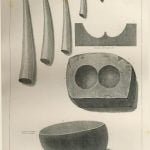
Men’s and women’s clothes were before the discovery made of skins, or dressed leather. It was necessary to the formation of garments for the body and legs, and shoes for the feet, that some hard and sharp instrument should be employed, capable of readily penetrating the skin or leather. The method of the ancient species of sewing of our tribes resembled that of a modern cordwainer rather than of a seamstress or tailor. Leather, dressed or undressed, being the material to be put together, this was accomplished by making holes in the edges of the garment or skin, and pushing through these the ends of deer sinews, or other fibrous integument. For this purpose the small and compact end of a horn, which is called aishkun by the Algonquins, was taken. Sometimes a rib bone, and at others the tibia of animals, was used. These articles are still employed for this purpose, for coarse work, among the remote tribes. These awls were of various sizes, as shown in figures 1, 2, 3, 4, 5. Plate 27.
The metallic needle is one of the articles supplied to these tribes by civilization. Sewing and the seamstresscal art, is an incident of high civilization.
